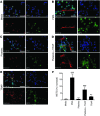Platelets induce neutrophil extracellular traps in transfusion-related acute lung injury
- PMID: 22684106
- PMCID: PMC3386815
- DOI: 10.1172/JCI61303
Platelets induce neutrophil extracellular traps in transfusion-related acute lung injury
Abstract
There is emerging evidence that platelets are major contributors to inflammatory processes through intimate associations with innate immune cells. Here, we report that activated platelets induce the formation of neutrophil extracellular traps (NETs) in transfusion-related acute lung injury (TRALI), which is the leading cause of death after transfusion therapy. NETs are composed of decondensed chromatin decorated with granular proteins that function to trap extracellular pathogens; their formation requires the activation of neutrophils and release of their DNA in a process that may or may not result in neutrophil death. In a mouse model of TRALI that is neutrophil and platelet dependent, NETs appeared in the lung microvasculature and NET components increased in the plasma. We detected NETs in the lungs and plasma of human TRALI and in the plasma of patients with acute lung injury. In the experimental TRALI model, targeting platelet activation with either aspirin or a glycoprotein IIb/IIIa inhibitor decreased NET formation and lung injury. We then directly targeted NET components with a histone blocking antibody and DNase1, both of which protected mice from TRALI. These data suggest that NETs contribute to lung endothelial injury and that targeting NET formation may be a promising new direction for the treatment of acute lung injury.
Figures






References
-
- [No authors listed]. Fatalities Reported To FDA Following Blood Collection And Transfusion: Annual Summary For Fiscal Year 2010. FDA Web site. http://www.fda.gov/downloads/BiologicsBloodVaccines/SafetyAvailability/... . Accessed on May 3, 2012.
Publication types
MeSH terms
Substances
Grants and funding
LinkOut - more resources
Full Text Sources
Other Literature Sources
Medical

